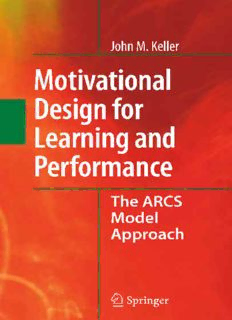Table Of ContentMotivational Design for Learning and Performance
John M. Keller
Motivational Design
for Learning and
Performance
The ARCS Model Approach
1 3
JohnM.Keller
InstructionalSystemsProgram
FloridaStateUniversity
3204GStoneBuilding
Tallahassee,FL32306-4453
USA
[email protected]
ISBN978-1-4419-1249-7 e-ISBN978-1-4419-1250-3
DOI10.1007/978-1-4419-1250-3
SpringerNewYorkDordrechtHeidelbergLondon
LibraryofCongressControlNumber:2009938709
#SpringerScienceþBusinessMedia,LLC2010
Allrightsreserved.Thisworkmaynotbetranslatedorcopiedinwholeorinpartwithoutthe
writtenpermissionofthepublisher(SpringerScienceþBusinessMedia,LLC,233SpringStreet,
NewYork,NY10013,USA),exceptforbriefexcerptsinconnectionwithreviewsorscholarly
analysis. Use in connection with any form of information storage and retrieval, electronic
adaptation, computer software, or by similar or dissimilar methodology now known or
hereafterdevelopedisforbidden.
Theuseinthispublicationoftradenames,trademarks,servicemarks,andsimilarterms,evenif
theyarenotidentifiedassuch,isnottobetakenasanexpressionofopinionastowhetherornot
theyaresubjecttoproprietaryrights.
Printedonacid-freepaper
SpringerispartofSpringerScience+BusinessMedia(www.springer.com)
This book is dedicated to
Cecilia
Preface
(cid:2) Whatarethecriticalcomponentsoflearnermotivation?
(cid:2) Whatistheresponsibilityofadesigner,instructor,counselor,coach,or
parentforlearnermotivation?
(cid:2) Howcanyoudeterminewhatmotivationaltacticstouseandwhentouse
them?
It is customary to begin a book or major article about motivation by
pointingoutthatitisapowerfulinfluence onperformanceandthatitisa
complexaspectofhumanbehavior.Thisbookisnoexceptioninthatregard.
Both of these generalizations are quite true, but it is also the case that
havingknowledgeaboutmotivationalconceptsandtheoriesisseldomsuffi-
cient for a person who is trying to design learning environments that will
stimulateandsustaintheirstudents’motivation.Thisbookhasbeenwritten
for people who are involved in designing or delivering instruction. This
includes instructional designers, performance technologists, trainers, tea-
chers,curriculumdevelopers,andanyoneelsewhoisresponsibleforstimu-
lating and sustaining peoples’ motivation to learn. The principles and
methodsinthisbookcanbeusedbyanyofthesepeopleinschoolsettings
aswellasprivate, public,andmilitarysectortrainingdesignanddelivery.
Furthermore,theapproachesdescribedinthisbookhavebeenusedinmany
internationalsettings.Onefinalpointisthattherearenoprerequisitesfor
students or professionals who use this book. It assumes no background in
psychologicalorpedagogicaltheory.
Purpose
Theaimofthisbookistoprovideanintroductiontotheconceptofmotiva-
tional design and to then support it with knowledge of motivational con-
cepts and theories, a systematic motivational design process, and tools to
support motivational design activities. Motivational researchers have pro-
ducednumerousstrategiesforstimulatingorchangingoneormorespecific
components of learner motivation and all of them are useful within their
specificareaofapplication.However,thegoalofthisbookistopresenta
generalized, systematic approach that is holistic in nature with regard to
the various aspects of learner motivation. The book aims at being ‘‘self-
sufficient’’ in that it provides a sufficient understanding of motivational
vii
viii Preface
concepts and theories to support the motivational design process and a
thoroughexplanationofthedesignprocessitself.
Anothergoalofthisbookistoassistthereaderinunderstandingmotiva-
tionalconceptswithinaframeworkthatisbroaderthanformalpsychologi-
cal research. Any reflection or research into the ‘‘why’’ questions
concerning why people do what they do are motivational questions, and
effortstoanswerthesequestionsarenotrestrictedtoanyparticularareaof
human inquiry. Scholars, philosophers, poets, novelists, and others have
contributed much to our understandings of these questions. Science leads
toward demonstrable principles but the other sources of knowledge can
makevaluablecontributionstoinsight,understanding,andempathy.Clin-
icians,inthebroadsenseoftheconcepttoincludedesigners,teachers,and
others, benefit from being able to interpret people’s behaviors within the
context of their values and experiences. I am convinced from long experi-
ence that it is helpful in understanding the richness of psychological con-
cepts to see how they have been articulated by people with different
perspectives and in different eras. Thus, there is a small amount of this
type of cultural and intellectual background in the chapters where the
foundational psychological concepts are described (Chapters 4 7), but
¯
the primary focus is on validated psychological constructs that are most
relevant to creating motivating learning environments and motivated
learners.
Background
My purpose in writing this book is to provide a validated, theoretically
based,proceduralapproachtoanalyzingmotivationalproblemsanddesign-
ing solutions. As illustrated by the various sections of this book, this
approach hasalonghistoryof development, it hasbeen implemented and
validated in many different contexts, and it is already familiar to a large
number of educators and educational researchers in many parts of the
world. Some partsof the book contain material that Ihave developed and
revised over many years and other parts describe recent developments. A
fundamental assumption of my approach is that motivational design is a
problem-solving process that proceeds from a rational analysis of the pro-
blems to the development of motivational strategies that are appropriate
forthoseproblems.Thisapproachisnotgroundedinaparticularpsycholo-
gical school of thought. Rather, it integrates virtually all of them by using
systems theory and certain superordinate concepts to give each theory a
place in the overall process where it provides the best explanations for
relationshipsinthatcontext.Thisorganizationalandconceptualstructure
isdescribedinthefirstthreechapters.
Preface ix
Organization
There are four parts to this book. The first part, Chapters 1, 2, and 3,
contains descriptions of what is meant by motivation, especially in the
context of learning, and to provide an in-depth explanation of what is
meant by motivational design. This is followed by an explanation of the
ARCS model which is the motivational theory and design process that pro-
videstheprimaryframeofreferenceinthisbook.‘‘ARCS’’isanacronymfor
Attention,Relevance,Confidence,andSatisfaction.Eachoftheseconcepts
represents a cluster of related motivational concepts and theories. The
ARCS model consists of this integration of research and best practices for
motivationandasystematicapproachtoapplyingthisknowledgetomotiva-
tionalproblemsolving.
Inthesecondmajorpartofthebook(Chapters4,5,6,and7)thereisa
chapter for each of the four major components of the ARCS model.
Together, these chapters provide a comprehensive summary of current
andhistoricallyimportantmotivationalconceptsandtheories.Eachchapter
hasapsychologicalfoundationscomponentthatincludesmotivationalcon-
ceptsandtheoriesthatarerelevanttothatsection.Eachofthesechapters
also has a section containing a set of subcategories based on the major
conceptsinthechapterandexamplesofmotivationalstrategiesandtactics.
Thethirdpartofthebook(Chapters8,9,and10)describesthesystema-
tic motivational design process. This process is explained in detail and
illustratedwithproceduralguidesintheformofworksheets.Thefirsttwo
ofthesechaptersincludetwoembeddedexamplesthatillustratehowtouse
thetemplatesandoneoftheseexamplesextendsintoChapter10.
The final part of thebook (Chapters 11and12) containsauxiliary infor-
mationincluding alternative approaches to motivational design depending
onthesettinginwhichitisbeingused;toolssuchaschecklistsandmeasure-
ment instruments to assist in application and research; ways of using the
design process in a variety of delivery systems including online instructor-
led and self-directed settings. Several recent areas of research that have
promiseforstimulatingadditionalresearcharealsoincluded.
Acknowledgments
Iamgratefultonumerouspeoplewhohavecontributedtothedevelopment
ofmyideasduringthepast30yearssinceIpublishedmyfirstpaperonthis
topicwhicheventuallyresultedinwhatisnowcalledtheARCSmodel.Itis
difficulttoidentifyeveryoneandasalwayswhencompilingalistsuchasthis
it is all too easy to omit someone who should be included. Before I even
presentmylist,Iwillapologizeforthat!Someofthepeoplewhoseinfluence
has been strongest due to their contributions to my ideas, their work with
meascollaborators,andtheirresearchwhichledtoconfirmationofvarious
aspectsoftheARCSmodelare,innoparticularorder,KatsuakiSuzuki,Chan
MinKim,MarkusDeimann,HermannAstleitner,Seung-YoonOh,TomKopp,
SangHoSong,RuthSmall,BonnieArmstrong,SanghoonPark,BernieDodge,
and Tim Kane. I also want to express my deep appreciation to my wife,
Cecilia,forhercarefulreviewofthetext,herhelpwithpreparationofthe
final manuscript, and for enabling me to spend enormous amounts of my
timeonthismanuscript.
xi
Contents
Preface........................................... vii
Acknowledgments ................................... xi
Chapter1: TheStudyofMotivation ..................... 1
Forethought ..................................... 1
Introduction..................................... 2
WhatisMotivation? ................................ 3
ARCS-V:AnExpansionoftheTraditionalARCSModel......... 7
ConceptualChallengesintheStudyofMotivation ......... 12
Affectivevs.CognitiveDomain ...................... 12
Traitvs.State.................................. 13
IntrinsicVersusExtrinsicMotivation..................... 17
Summary ....................................... 19
Chapter2: WhatisMotivationalDesign? .................. 21
Forethought ..................................... 21
Introduction..................................... 21
CharacteristicsofDesign ............................ 22
MotivationalDesignModels........................... 26
Person-CenteredModels........................... 26
EnvironmentallyCenteredModels .................... 31
Interaction-CenteredModels........................ 33
OmnibusModels ................................ 34
ProcessVersusModels:BenefitsofaHolistic,Systems
Approach ....................................... 35
DesignChallengesWithRegardtoMotivation .............. 35
IsolatingandDefiningtheMotivationalProblems.......... 37
DecidingWhethertoChangethePersonorthe
Environment.................................... 37
TheLimitationsofMotivationalDesign................... 38
Summary ....................................... 39
Chapter3: TheArcsModelofMotivationalDesign........... 43
Forethoughts .................................... 43
Introduction..................................... 44
xiii
Description:It is impossible to control another person’s motivation. But much of the instructor’s job involves stimulating learner motivation, and learning environments should ideally be designed toward this goal. Motivational Design for Learning and Performance introduces readers to the core concepts of mo

